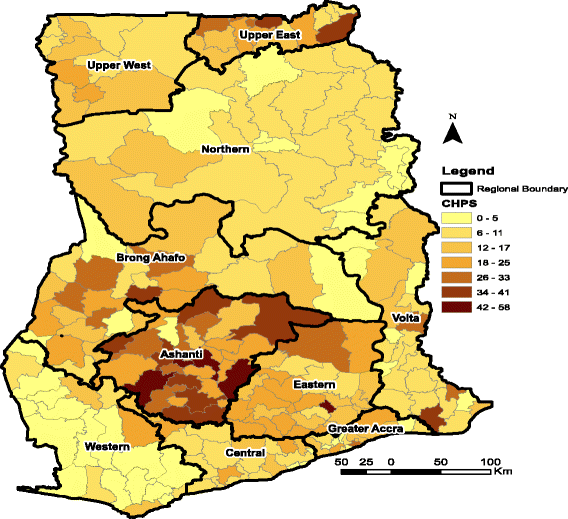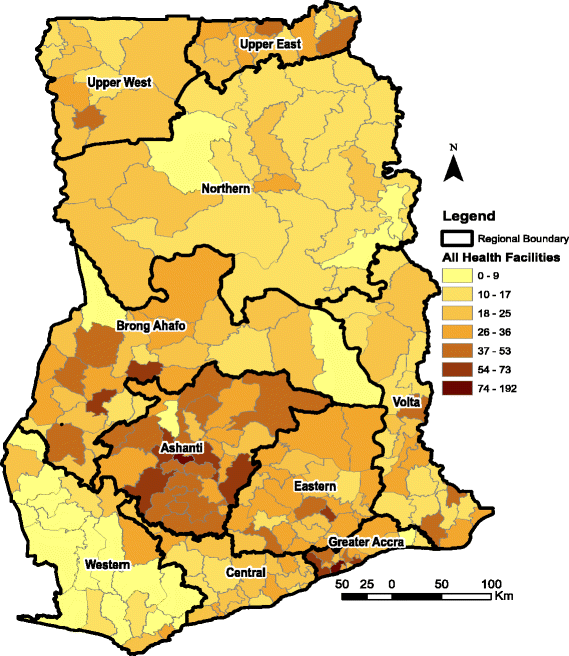Spatial variation in the use of reproductive health services over time: a decomposition analysis
- PMID: 29510675
- PMCID: PMC5838884
- DOI: 10.1186/s12884-018-1695-3
Spatial variation in the use of reproductive health services over time: a decomposition analysis
Abstract
Background: The paper argues that several Sub-Saharan African countries have recorded marked improvements in the use of reproductive health services. However, the literature has hardly highlighted such progress and the factors responsible for them. The current study uses Ghana as a case to examine progress in the consumption of reproductive health services over the last two decades and the factors responsible for such progress.
Methods: The study uses two rounds (1998 and 2014) of Demographic and Health Survey data from Ghana. Standard frequencies, a logit model and decomposition of the coefficients of the logit model (i.e. Oaxaca-type decomposition) was employed to examine changes in the use of reproductive health services (4+ antenatal visits and skilled attendance at birth) at national and sub-national levels (i.e the four ecological zones of Ghana) between 1998 and 2014 as well as factors explaining observed spatial changes between the two periods.
Results: Descriptive results suggest that the highest level of improvement occurred in resource-poor zones (i.e. northern belt followed by the southern belt) compared to the middle belt and Greater Accra, where access to resources and infrastructure is relatively better. Results from Oaxaca-type decomposition also suggest that women and partner's education, household wealth and availability and accessibility to health facilities are the key factors explaining spatial variation in reproductive health service consumption over the two periods. Most importantly, the marginal efficiency of investment in women and partner's education and access to health services were highest in the two resource poor zones.
Conclusion: There is the need to target resource poor settings with existing or new pro-poor reproductive health interventions. Specifically, the northern and southern zones where the key drivers of education and availability of health facilities are the lowest, will be key to further improvements in the consumption of reproductive health services in Ghana.
Keywords: Decomposition; Reproductive health; Spatial variation.
Conflict of interest statement
Ethics approval and consent to participate
The study used purely secondary data (i.e. the Ghana Demographic and Health Survey) which is a publicly available data at the Measure DHS website upon request. Thus, the usage of the data is covered by the ethics approval secured by Measure DHS for the collection of the initial data.
Consent for publication
Not applicable
Competing interests
The author declares that the paper was funded fully from his personal resources and neither are there any political or other interest to declare.
Publisher’s Note
Springer Nature remains neutral with regard to jurisdictional claims in published maps and institutional affiliations.
Figures


Similar articles
-
Examining trends in inequality in the use of reproductive health care services in Ghana and Nigeria.BMC Pregnancy Childbirth. 2018 Dec 13;18(1):492. doi: 10.1186/s12884-018-2102-9. BMC Pregnancy Childbirth. 2018. PMID: 30545328 Free PMC article.
-
Measuring and explaining changing patterns of inequality in institutional deliveries between urban and rural women in Ghana: a decomposition analysis.Int J Equity Health. 2019 Aug 9;18(1):123. doi: 10.1186/s12939-019-1025-z. Int J Equity Health. 2019. PMID: 31399050 Free PMC article.
-
Patterns of access to reproductive health services in Ghana and Nigeria: results of a cluster analysis.BMC Public Health. 2020 Apr 23;20(1):549. doi: 10.1186/s12889-020-08724-3. BMC Public Health. 2020. PMID: 32326928 Free PMC article.
-
Explaining Disparities in Use of Skilled Birth Attendants in Developing Countries: A Conceptual Framework.PLoS One. 2016 Apr 22;11(4):e0154110. doi: 10.1371/journal.pone.0154110. eCollection 2016. PLoS One. 2016. PMID: 27105309 Free PMC article.
-
The availability and distribution of health services and resources across different regions in Afghanistan.Front Public Health. 2025 Jan 24;12:1371104. doi: 10.3389/fpubh.2024.1371104. eCollection 2024. Front Public Health. 2025. PMID: 39926293 Free PMC article. Review.
Cited by
-
Inequality in Utilization of Maternal Healthcare Services in Low‑ and Middle‑Income Countries: A Scoping Review of the Literature.Matern Child Health J. 2025 Jun;29(6):741-766. doi: 10.1007/s10995-025-04111-9. Epub 2025 Jun 3. Matern Child Health J. 2025. PMID: 40461773 Free PMC article.
-
Wealth inequalities in reproductive and child health preventive care in Mozambique: a decomposition analysis.Glob Health Action. 2022 Dec 31;15(1):2040150. doi: 10.1080/16549716.2022.2040150. Glob Health Action. 2022. PMID: 35290171 Free PMC article.
-
Inequalities in reproductive health care use in five West-African countries: A decomposition analysis of the wealth-based gaps.Int J Equity Health. 2020 Mar 27;19(1):44. doi: 10.1186/s12939-020-01167-7. Int J Equity Health. 2020. PMID: 32220250 Free PMC article.
-
Trends in utilisation and inequality in the use of reproductive health services in Sub-Saharan Africa.BMC Public Health. 2019 Nov 21;19(1):1541. doi: 10.1186/s12889-019-7865-z. BMC Public Health. 2019. PMID: 31752773 Free PMC article.
-
A Scoping Review of Spatial Analysis Approaches Using Health Survey Data in Sub-Saharan Africa.Int J Environ Res Public Health. 2020 Apr 28;17(9):3070. doi: 10.3390/ijerph17093070. Int J Environ Res Public Health. 2020. PMID: 32354095 Free PMC article.
References
-
- WHO. Trends in maternal mortality: 1990 to 2013 estimates by WHO, UNICEF, UNFPA, the World Bank and the United Nations population division. Geneva: World Health Organisation. p. 2014.
-
- Unicef . Improving child nutrition: the achievable imperative for global progress. New York: UNICEF; 2013.
-
- Save the Children. Surviving the first day. In: State of the world’s mothers 2013. Westport Connecticut: Save the Children; 2013.
-
- Ghana Statistical Service (GSS) Ghana Health Service (GHS) ICF International . The 2014 Ghana demographic and health survey (DHS) key findings. Rockville: GSS, GHS, and ICF International; 2015.
-
- Ministry of Health . Independent annual review of the health sector Programme of works for 2007. Accra: Ministry of Health, Ghana; 2008.
MeSH terms
LinkOut - more resources
Full Text Sources
Other Literature Sources
Medical

